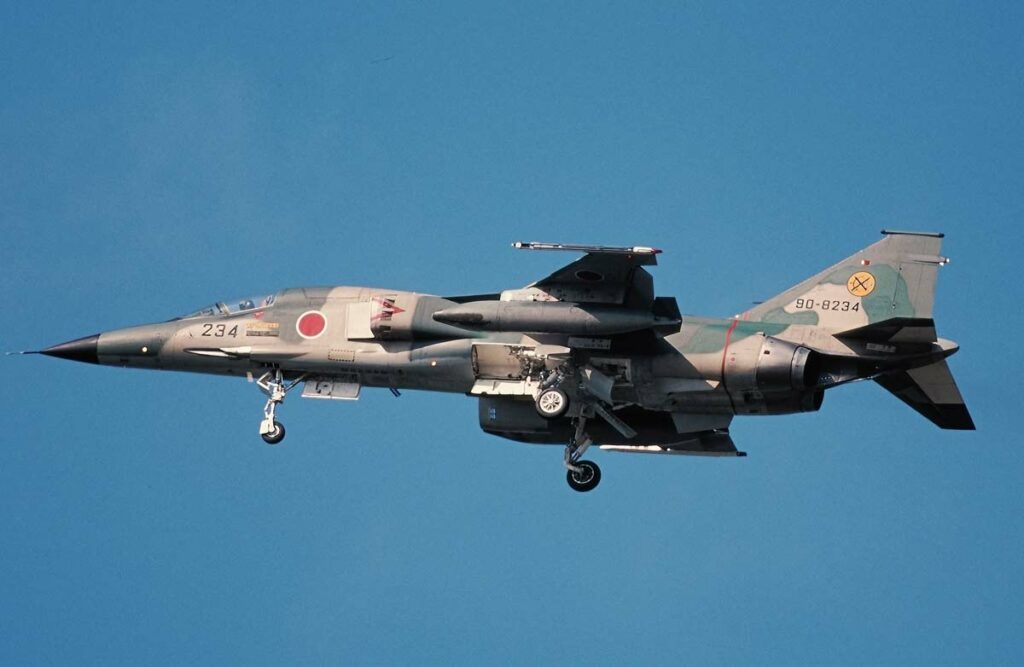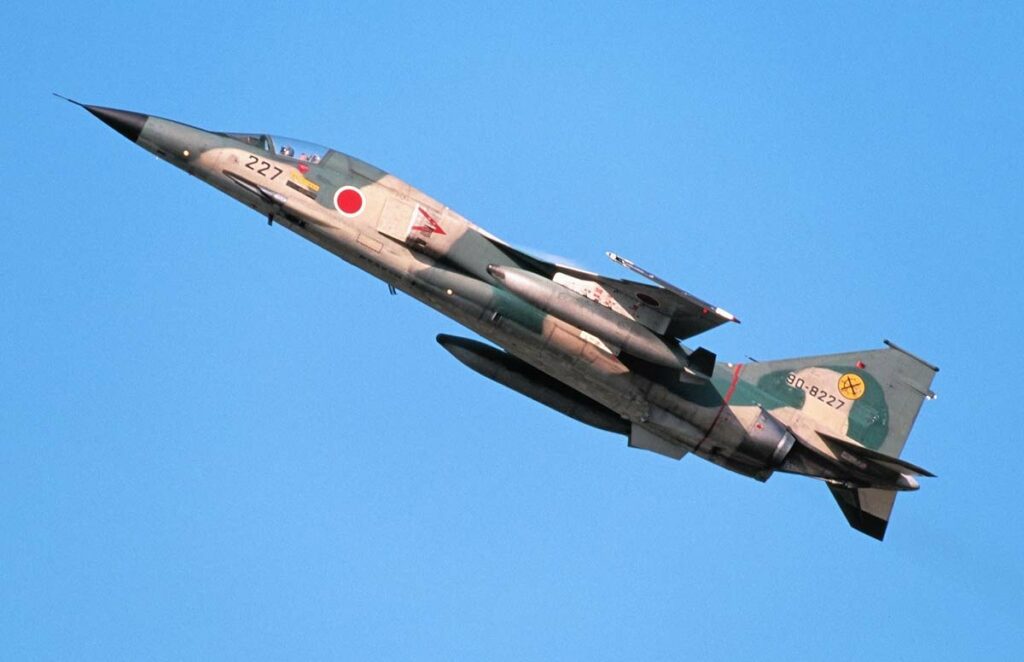Japan’s first domestically developed supersonic military jet, designed for anti-ship and ground attack.
In Brief
The Mitsubishi F-1 is Japan’s first domestically produced supersonic fighter aircraft, derived from the Mitsubishi T-2 trainer. Entering service in 1978, the F-1 was designed primarily for anti-ship and ground attack roles. It is powered by two Ishikawajima-Harima TF40-IHI-801A turbofan engines, each providing up to 13,500 pounds of thrust with afterburners. The aircraft features a maximum speed of Mach 1.6, a range of approximately 1,730 kilometers, and can reach altitudes up to 50,000 feet. Equipped with sophisticated avionics, including radar capable of ground mapping and targeting, the F-1 carries a range of weaponry tailored to its mission profiles, such as ASM-1 anti-ship missiles, air-to-air missiles, and conventional bombs.

History of the Development of the Mitsubishi F-1
In the context of the Cold War era, with escalating regional tensions in Asia, Japan recognized the need for an advanced military aircraft capable of providing substantial defensive capabilities and asserting sovereignty. This need led to the development of the Mitsubishi F-1, marking a significant shift in Japan’s post-war defense policy which traditionally relied on imported Western technology.
The project, initiated by the Japanese Defense Agency in collaboration with Mitsubishi Heavy Industries, aimed to transform the Mitsubishi T-2 advanced jet trainer into a fully combat-capable aircraft. This approach was chosen to reduce costs and development time by leveraging the existing T-2 platform’s technology and infrastructure. The program officially started in the early 1970s, with the prototype aircraft, then known as the FS-T2-Kai, first taking to the skies on June 3, 1975.
The Mitsubishi F-1 did not receive a specific NATO nickname, reflecting its exclusive operation within the Japan Air Self-Defense Force (JASDF) and its limited recognition in Western military circles at the time. The development of the F-1 was driven by Japan’s strategic need for a versatile attack platform capable of conducting anti-ship operations, air-to-ground support, and limited air defense duties.
Design of the Mitsubishi F-1
The design of the Mitsubishi F-1 is heavily based on its predecessor, the T-2 trainer, but with significant modifications for combat roles. Measuring 17.86 meters in length with a wingspan of 7.88 meters, the aircraft incorporates a robust airframe capable of withstanding the rigors of low-altitude, high-speed flight. Its two Ishikawajima-Harima turbofan engines are equipped with afterburners, enhancing its thrust and speed capabilities crucial for quick response and evasion maneuvers.
One of the major design features of the F-1 is its advanced avionics suite, which includes a radar system capable of precise ground mapping and targeting, essential for its primary role in ground and maritime attack missions. Additionally, the aircraft is fitted with a modern electronic countermeasures system to enhance survivability in hostile environments.
The aircraft’s loadout capabilities are significant, with hardpoints under the wings and fuselage to carry a variety of weapons systems. Despite these strengths, the F-1’s design does have drawbacks, such as limited range and payload compared to larger, more modern fighters. Moreover, the reliance on the older airframe design of the T-2 limits its upgrade potential and adaptability to new technologies.
Performance of the Mitsubishi F-1
The Mitsubishi F-1’s performance is characterized by its supersonic capabilities, achieving speeds up to Mach 1.6, with a practical range of about 1,730 kilometers. Its service ceiling reaches 50,000 feet, providing ample altitude for various mission profiles. Each engine’s thrust enables the aircraft to maintain high speeds and perform intensive maneuvers, which are crucial in evading enemy fire and engaging fast-moving targets.
When compared to contemporaries like the American F/A-18 Hornet or the French Mirage F1, the Mitsubishi F-1 holds its own in speed and maneuverability but generally falls short in terms of multirole flexibility and advanced avionics integration. However, for its designated roles within the JASDF, it proved to be an effective platform.
Variants of the Mitsubishi F-1
The primary version of the Mitsubishi F-1 remained relatively unchanged throughout its service life, with no major variants produced. However, minor updates and modifications were made to enhance its avionics and weapons systems, ensuring the aircraft remained effective against evolving threats and changing mission requirements.

Military Use and Combat of the Mitsubishi F-1
The Mitsubishi F-1 was primarily deployed by the Japan Air Self-Defense Force for maritime patrol and ground attack missions. Its arsenal, capable of deploying ASM-1 anti-ship missiles, was particularly valued for Japan’s coastal defense strategy. The F-1 was active in regular exercises and patrols around Japanese waters, demonstrating its capabilities in realistic combat simulations and drills.
While the F-1 was not used in actual combat situations, its presence significantly contributed to the deterrence and defense posture of Japan during its service period. The aircraft was eventually phased out and replaced by more modern aircraft like the Mitsubishi F-2, a development that reflects advancements in military aviation technology and changing defense needs of Japan.
The Mitsubishi F-1 marks a significant milestone in Japan’s aerospace and defense industry as the first domestically produced supersonic military aircraft. Its development and deployment underscore Japan’s efforts to establish a self-reliant defense capability tailored to regional security dynamics and technological advancement. While it has been surpassed by more modern aircraft, the F-1’s legacy in the evolution of Japan’s military aviation capabilities remains influential.
Back to the Fighter Jet section.